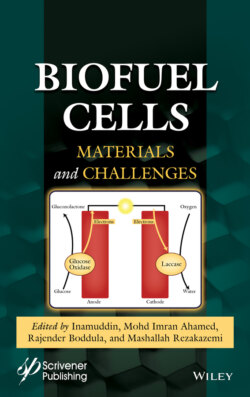Читать книгу Biofuel Cells - Группа авторов - Страница 21
1.4.3 Nitrogen-Doped Carbonaceous Materials as Bioelectrodes for BFCs
ОглавлениеThe doping of carbon-based materials with heteroatoms (N, B, P, and S) is a route to activate the π electrons through creation of charge sites, being these responsible of an enhanced conductivity and activity toward the oxygen reduction reaction (ORR). Highly conductive supports like graphene have been modified with heteroatoms for their use as cathodes in hybrid biofuel cells. Du et al. grew N-doped carbon nanotubes on reduced graphene oxide (rGO) nanosheets to improve the performance of a microbial fuel cell (MFC) [110]. The maximum power density achieved by this biofuel cell was 1,329 mW cm−2, which was 1.37 times higher to that achieved by benchmarked Pt/C, and the improvement was associated to the strong covalent bonds formed between the carbon nanotubes and graphene facilitating the electron transfer between these interfaces. Zhong et al. followed a similar strategy developing a N-doped hierarchical carbon [111]. This material also contained Fe species in its structure, and was obtained through the carbonization of metal–organic frameworks (MOFs). This material was used as cathode in a microbial fuel cell using carbon felt and carbon cloth as anode and cathode, respectively, and the highest performance reported was 1,607.2 mW cm−3.
N-doped materials have been used in the anode compartment of microbial fuel cells. Guan et al. [112] synthesized N-doped carbon dots on carbon paper electrodes to improve microbial immobilization. One of the first findings was that the biofilm has 2 times higher thickness in this electrode in contrast with an unmodified carbon paper electrode. In addition, the cell performance was boosted because the extracellular electron transfer process from the microorganisms to the electrode was improved. Zhang et al. [113] used a N-doped graphene as support for a Mo2C nanocatalyst to improve the hydrogen evolution reaction in a microbial fuel cell stacked with an ammonia electrolytic cell. The authors reported a maximum power density of 536 mW cm−2, achieved using four air-cathode MFCs stacked in series. Guo et al. [114] also improved the anode of a MFC synthesizing a N-doped 3D expanded graphite foam, which displayed a maximum power density of 739 mW cm−2, 17.4 times higher than the performance obtained by a simple graphite foil. The activity improvement was attributed to a higher surface area which allowed a bigger growth of the biofilm.
N-doped carbonaceous materials have been also used in enzymatic biofuel cells. Li et al. [115] reported a covalently coupled ultrahigh quaternary N-doped reduced graphene/carbon nanotube as support for glucose/O2 enzymatic BFCs. The improvement between electron-accepting pyridinic-N and electron-donating quaternary-N resulted in an ultrahighdonating quaternary N-doping material, improving the electron transfer and thus, the BFC displayed an OCV of 0.89 V with a maximum power density of 0.9 mW cm−2.
